Basic Definition of kitchen
The kitchen is a workplace inside the home that is used for cooking and food preparation. It is also an important living room and meeting point for the occupants and their guests, with various relationships to other areas of the house. A residential kitchen should have the following equipment inside: a stove, a sink with hot and cold running water, a fridge, kitchen cabinets, and a worktop. Apart from these, a modern kitchen should have a microwave oven, dishwasher, and other electrical appliances. These should be arranged in a good manner or according to a modular design. The kitchen is mainly used to prepare or cook food. [1] [5]
According to the building regulations, every house or flat must have at least one kitchen for cooking. Kitchens without windows are generally undesirable and only permissible if effective ventilation is guaranteed. A kitchen’s clear ceiling height should be at least 2400 mm, and the window area should be at least 1/s of the net floor area. [1]
Below in the article, you will find out the kitchen standard dimensions…
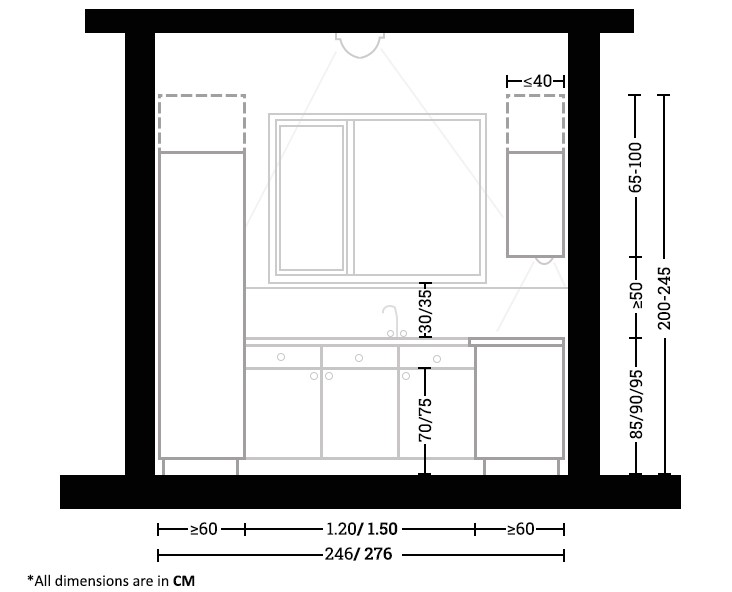
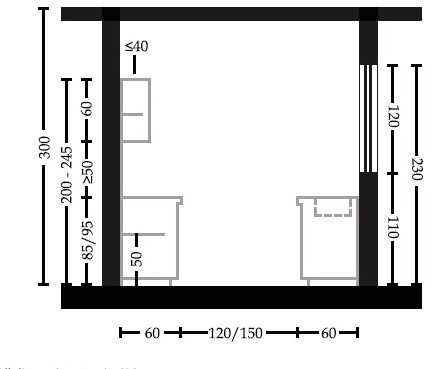
Suitable location of the Kitchen
The kitchen should be located in the northeast or northwest corner of the house. The distance between the kitchen and the entrance area should be shorter. It should be near the dining room, utility room, and larder. The kitchen should be placed ideally so that it is possible to see the front door, children’s play area, and garden door. [1]
Location of the kitchen as per Vaastu
The southeast direction is ideal for an east-facing house, as per Vaastu, and if the location is not available, then it can be designed in the northwest, west, or northeast directions. The northwest direction is suitable for some people and their health, especially for women. [6] The kitchen design is primarily based on sun and wind directions (Vayu or Surya Dev). [6] [7] A kitchen should be designed in such a way that direct sunlight and air can enter the room. Light and air are beneficial as they kill germs and provide fresh air by removing food odors, fumes, and other things. That’s why the orientation of the kitchen is very necessary. [7]
Types of Kitchen based on the layout

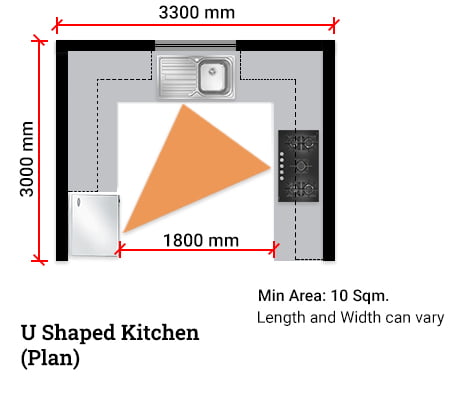
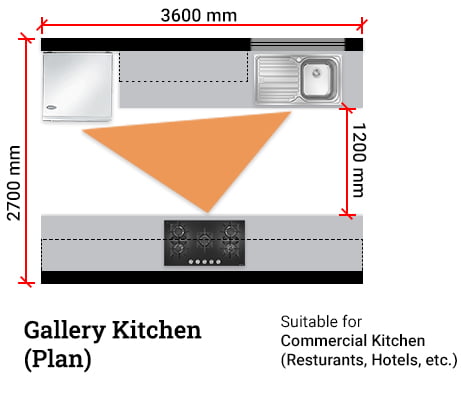
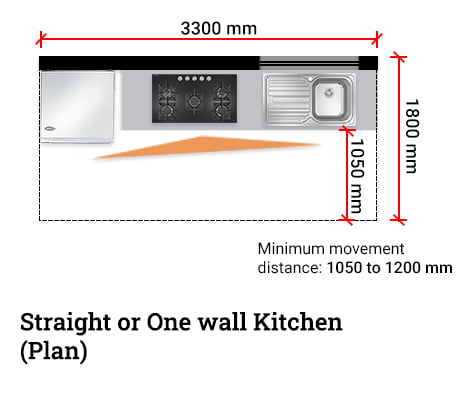
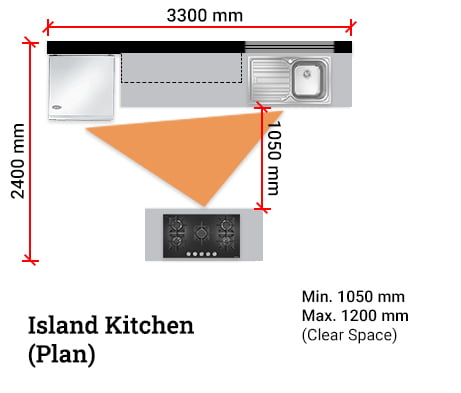
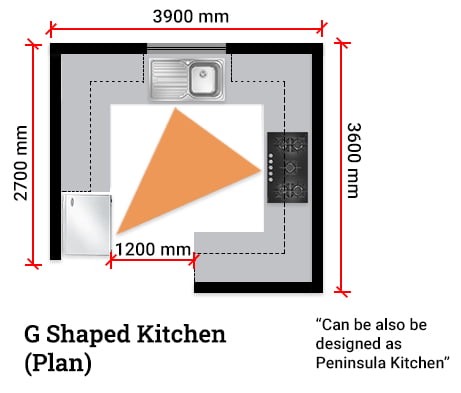
- The standard dimensions of kitchen is 2400 mm x 2400 mm.
- The kitchen can be designed on these dimensions 2400 x 3000 mm, 2400 x 3600 mm, 2400 x 3900 mm, 3000x 3600 mm etc.
- The minimum area of a kitchen should be 6 sqm. [8]
- L-shaped kitchens are a simple and practical option that may allow a table to be incorporated into the remaining area of the room. [2]
- The typical L-shaped kitchen allows for the location of a small breakfast area in the opposite corner.
- U-shaped kitchens are an ideal layout for creating a work triangle and also provide a generous amount of storage space. [2] [4]
- An island is ideal for cutting down on distances and restoring the work triangle in larger kitchens where units are placed around the perimeter.
- Islands can also be used to separate the kitchen area from the dining or living area. [2]
- In contrast, the island unit encourages excessive walking while providing insufficient worktop space. [3]
- The gallery kitchen is typically accessible from both ends, often converting it from a workspace to a corridor. [4]
Design Parameters for Kitchen
Work Sequence
The planning of a kitchen should make possible a flowing work sequence with sufficient space for movement while avoiding unnecessarily long distances. A movement area of 1500 mm (minimum 1200 mm) is therefore required between the stretches of the worktop. With most kitchen units having a depth of 60 cm on each side of the movement area, this results in a minimum kitchen width of 2700 mm (min. 2400 mm) (plus approximately 60 mm spacing up to the wall). [1]
The following pattern should guide the order of activities in the work sequence:
First: Store: Gather all of the items and place them in the refrigerator, larder, or cupboards.
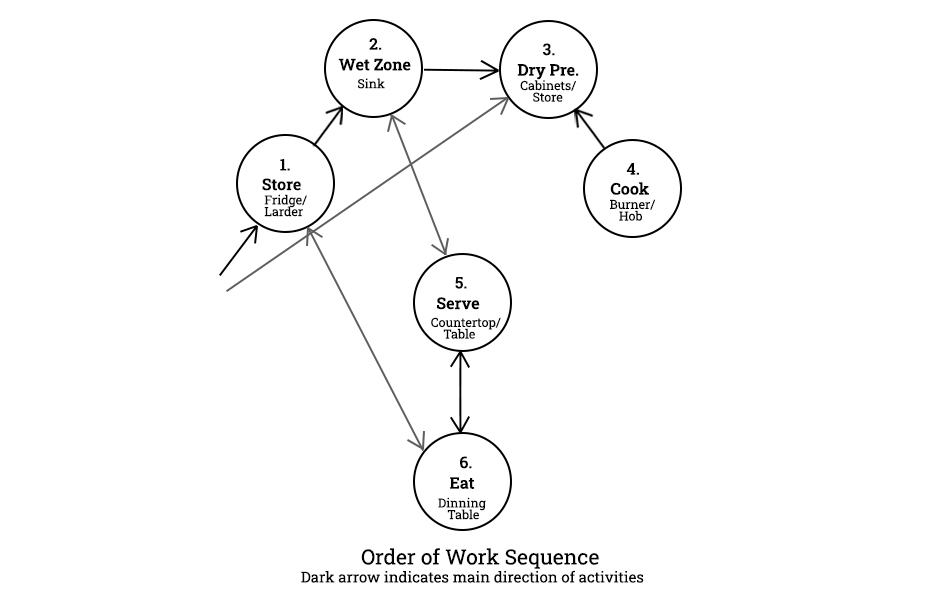
Second: Wash: Washing the food items, peeling them, chopping, etc.
Third: Prepare: Prepare the food, mixing it with other items.
Fourth: Cook: Finally cook all the prepared items
Fifth: Serve: Serving the prepared food
Sixth: Eat: At last eat it on the dining table.
After this sequence is complete, the return sequence should be as follows:
Clear: Remove all the utensils and dishes and return them to the sink or utility area.
Wash: Washing all dirty utensils and storing them in cabinets or cupboards
The preferred sequence is normally planned from left to right or in a clockwise direction, but this is not essential and may be prejudiced against right-handed people. The left-hand cook may prefer a reversed order. [3]
The Working triangle/Kitchen Triangle
You would have noticed three major activities in the kitchen after going through the work sequence, which corresponds to the three major appliances: the fridge, sink, and burner. The “working triangle” or “kitchen triangle” depicts the interaction of these three activities. The area highlighted in orange in the figure below is the working triangle.
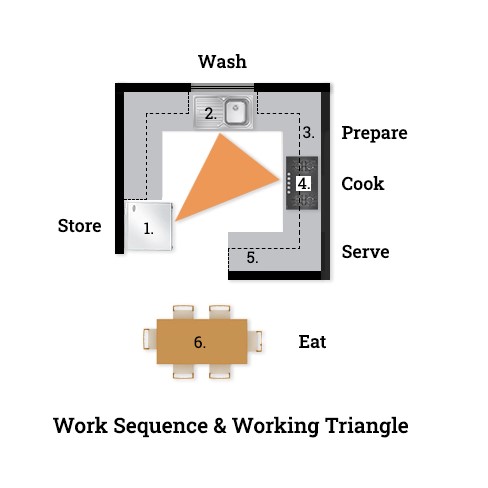
Kitchen triangle
The ideal length is between 3600 and 6600 mm.
Less than 3600 mm means the worktop is too short.
More than 6600 mm is time-consuming and hard on the feet.
After adding the values of the three sides of the working triangle, the values from the center of the appliances should not be less than 3500 mm or more than 6500 mm long. Because if the distance is less, then the working area inside the kitchen is insufficient, and if the distance is more, a user will have to travel unnecessarily, which will make the working process slow and also exhaust the user. [3]
The working triangle should be free from unnecessarily busy traffic and furniture placement. Disturbing the triangle can lead to many work issues inside the kitchen.
The ideal height of the countertop of the kitchen
There has been much discussion about the ideal countertop height; everyone has their theories and criteria for providing the standard height of the kitchen worktop. The height should be ideal, and it should not discomfort the user.
According to Neufert the height of the worktops should be adopted to suit the user and can vary between 850 mm to 950 mm.
According to Metric Handbook, the ideal height should be 100 mm below the elbow height.
Recent studies suggest that the standard height of 900 mm is too low and could be increased to 950 mm or even 975 mm. While it is true that working at a worktop that is too high rather than too low is more comfortable, worktops must also accommodate elderly people whose height has shrunk and children who are not yet fully grown. So in this respect, the 900 mm height is not a bad compromise. [3]
But, I suggest calculating the height of the worktop by this method:
Height of the user ÷ 2 + 5cm = Height of the countertop.
This method can work to some extent, but if there are a lot of users in the kitchen, it can create some issues.
If you’re wondering what the standard height of a countertop should be, it should be between 900 mm and 950 mm.
Ideal Vertical Dimensions
The height of cupboards, drawers, and shelves should be such that we do not have to bend too low or stretch too high. A comfortable height range is between 750 mm and 1500 mm.
A woman’s maximum upward reach while standing in front of the counter is 1950 mm.
The average eye level for men and women is 1567 mm. [3]
In overhead cabinets, the upper shelves are usually inaccessible to the smaller person, while the lower shelves are usually inaccessible to most without bending or kneeling. The logical answer is the development of kitchen cabinet systems capable of total adjustability to accommodate the human dimension of the individual user. Such a system could accommodate not only those of smaller and larger body sizes but also elderly and disabled people. [4]
A kitchen that is intended to be used as a dining area should have a floor area of at least 7.5 m2 and not less than this, and a minimum width of at least 2100 mm. [8]
For more kitchen standard dimensions fixtures click here (You can also download these CAD Blocks, for free):-
To read about types of finishes for modular kitchens, click here:-
https://layakarchitect.com/types-of-finishes-for-modular-kitchen/
To read about popular flooring options for the kitchen, click here:-
To know about the standard dimensions of cabinets, appliances, and other equipment, you should refer to the Neufert, Timesavers, and other standard books, or I would prefer going with the booklets or brochures of the companies involved in designing or making those types of equipment.
Ergonomics/Standard dimensions related to kitchen
Dimensions are a very important part of the design process, and going with standard dimensions creates an ideal and functional space. Below are some images that show the standard kitchen dimensions that should be followed. All the dimensions listed below are in centimeters. (Source: Neufert, Timesavers, Metric Handbook, etc.)
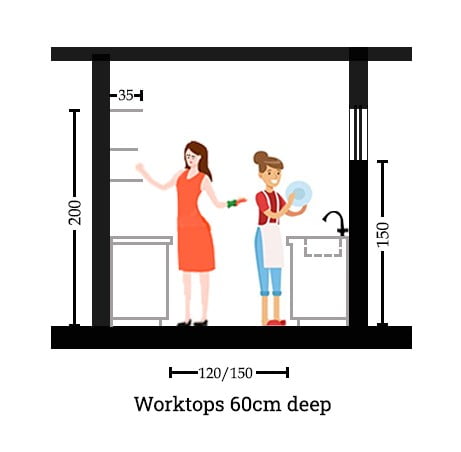
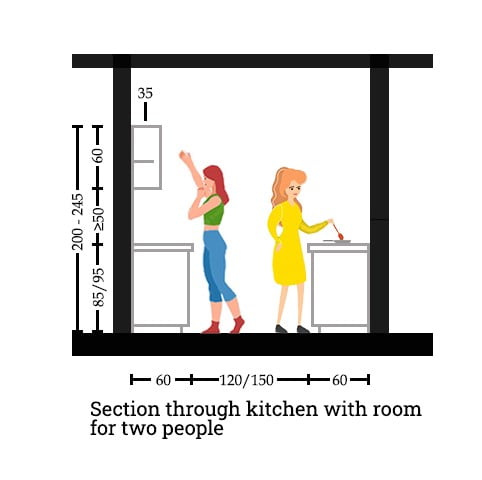
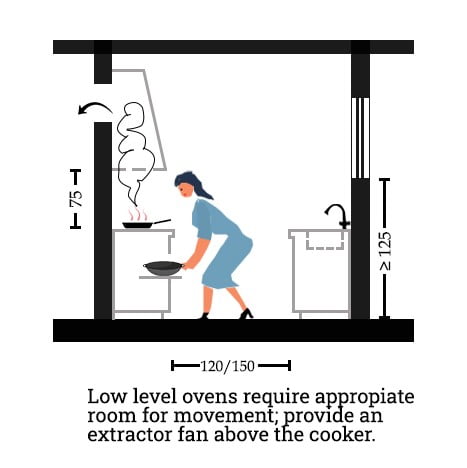
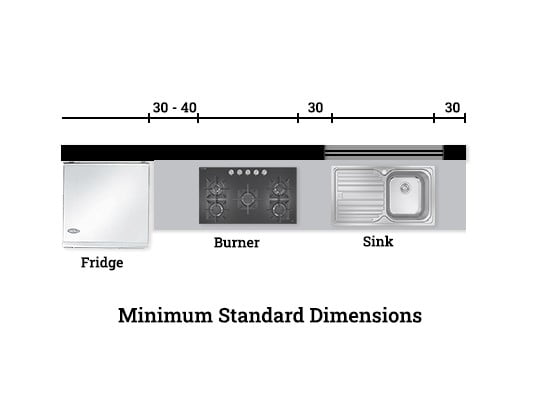

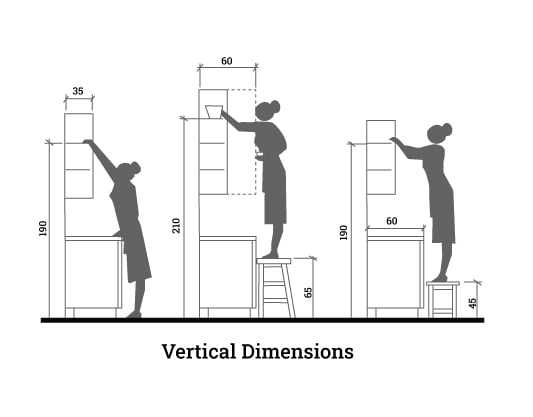
Avoid mistakes while designing the kitchen
Poor circulation
There’s nothing worse than not giving the user enough space to freely move around in the kitchen. Whether the kitchen is big or small, proper circulation should be a priority in the kitchen. If you want to provide adequate circulation, include 1200 mm of space between the countertops or island. If the kitchen is small, allow at least 1050 mm of circulation space.
Ignoring the working triangle or kitchen triangle
The working triangle is essential for a good workflow inside the kitchen. The triangle connects the cooktop, sink, and refrigerator so that the flow between these spaces is seamless. Each edge of the working triangle (the distance between each work area) should measure between 1200 mm and 2700 mm, allowing the user to cook, clean, and store items easily. The triangle should, of course, never be obscured, and no major traffic (other than the user cooking) should cross through that area.
Installing wrong-size appliances and cabinets
The most common kitchen design mistake is using appliances and cabinets that are the wrong size. Oversized dishwashers, refrigerators, microwave ovens, and other appliances. Kitchen standard dimensions should be taken into the consideration.
Inadequate lighting
Providing ample lighting in the kitchen is a priority. Pendant lights that function as task lighting above the kitchen island are a great addition to any kitchen. You can also opt for under-cabinet lighting and recessed lights for extra visibility. Just remember: overhead lighting can be harsh and can create unwanted shadows; therefore, opting for task lighting is a better option.
Not utilizing vertical space
Ignoring vertical space can present many challenges, especially in a small kitchen. Vertical space provides valuable storage options, and wasting this space can create many issues in the kitchen. Vertical dimensions of the kitchen can provide additional space.
In the case of the dining kitchen, the dining area should be accessed first to avoid guests walking through the kitchen unnecessarily.
A Question from the Readers
What are the benefits of connecting the dining space with the kitchen area?
Comment with your answers below.




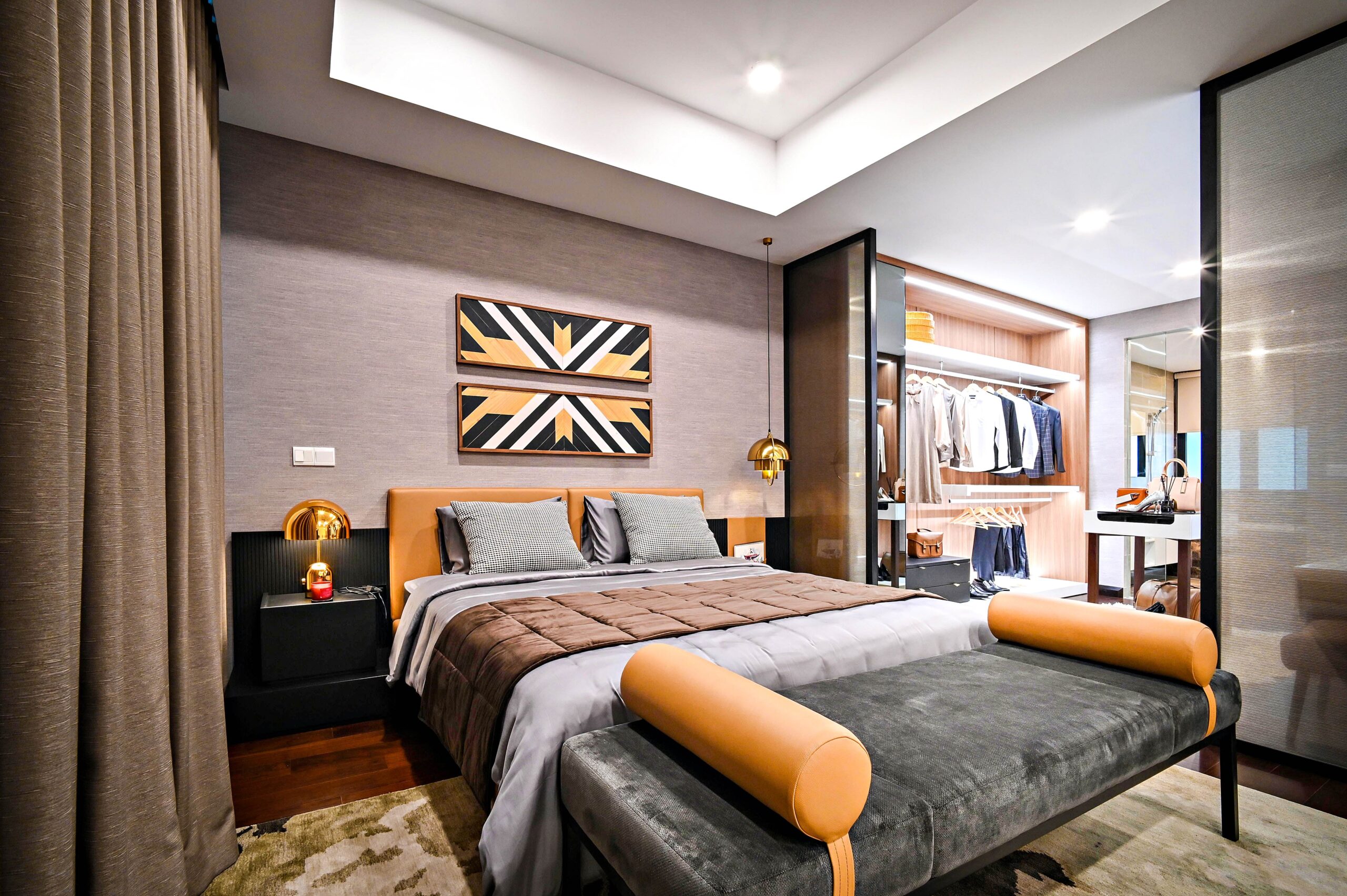







2 Responses
vero odio quam et ut itaque aperiam possimus explicabo. aut animi sed et officia est quod. autem et culpa laborum nisi.
“Thank you for your message, but I can’t really understand your question or what you want to say. But if you have any more questions or need assistance, I will be pleased to respond.”